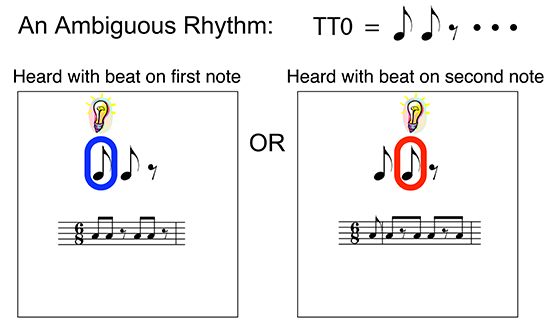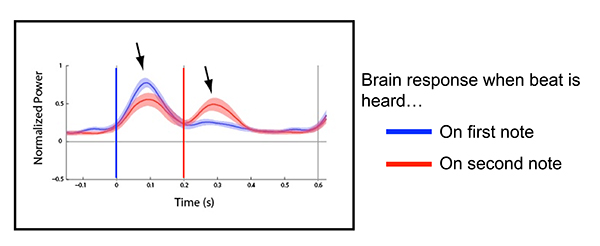John Iversen,
The Neurosciences Institute,
San Diego, CA
iversen@nsi.edu
Aniruddh Patel,
The Neurosciences Institute,
San Diego, CA
apatel@nsi.edu
Popular version of paper number 1aMU3
"Neural dynamics of beat perception and production"
Presented at 9:35 a.m. on Monday, November 10, 2008
156th Meeting of the Acoustical Society of America, Miami, FL
But it may be that the deep connection between music and movement can be used to help those with movement disorders. The field of music-therapy has documented the powerful effect of rhythmic music on the motor system. 1 Some patients with Parkinson’s disease can become “unfrozen” and able to walk when they synchronize their movements to a musical beat. 2 However, the neural mechanisms behind the deep connection between sound and movement remain largely unknown.
Our work seeks to understand the mechanisms underlying the human ability to synchronize movement with sound through a combination of neurobiological and cross-species approaches. 3, 4 It is hoped that this basic research will lead to the understanding needed to refine and understand the clinical use of music to aid those with motor difficulties. Specifically, we are studying the neural underpinnings of beat perception. Perceiving a beat is an essential component in our ability to move to music, as it defines the timing of how we clap or dance to music.
How do we study this? One way is to measure brain responses when a listener hears a simple, yet ambiguous, rhythm. The way the rhythm actually sounds actually depends on where the listener hears the beat. Our perceptions are shaped by interpretation. The first rhythm that we used is a repeating pattern of two tones followed by a rest, a swing pattern: da dah da dah… (Figure 1.) We ask people to imagine that the beat is either on the first note (making it sound like DA dah DA dah) or on the second note (da DAH da DAH). The key is that the emphasis is only in the listener’s mind, and the tones in the rhythm are all at the same volume. This gives us a way to measure the contribution of beat perception to the brain’s response. In all of our studies, participants are told not to move or engage in mental imagery of movement.

We measure brain responses using magnetoencephalography. MEG is a technique that measures the minute magnetic fields around the head that are caused by nerve activity in the brain. It is non-invasive, quiet and offers a detailed temporal picture of brain activity. Figure 2 shows a picture of the MEG machine, and an example of a brain response to the two notes of the rhythm. Note that the brain responds with a burst of activity after each note.

We have shown that the response gets stronger when a tone is heard as the beat (Figure 3). This suggests that some part of the brain is able to modulate auditory responses in a temporally precise way. 3 Interestingly, the way that imagining a beat enhances the brain’s response also mimics how the brain response is increased when that tone is actually made louder, and suggests this might show one way in which the brain is able to modify our perceptions.

The brain modulation that we observed due to imagined beats was in a specific frequency range called “beta” (15 to 30 oscillations per second), known to be associated with motor system activity and communication within the brain. Because of this, and because of recent work showing that motor areas are activated while listening to rhythms with a beat, 5 we hypothesize that this modulation arises in the motor system. If this is true, it suggests not only that sound can entrain our movements, but conversely that there is a mechanism by which motor processes can shape auditory perception, even in the absence of movement. To test this hypothesis we are beginning to trace the temporal interactions between different brain systems.
Together with ongoing research by other groups, we hope to fully describe auditory-motor interactions as a foundation for understanding normal musical behavior and music-based movement therapy.
Acknowledgements
We thank Lacey Kurelowech for research assistance. This work was supported by Neurosciences Research Foundation as part of its program on music and the brain at The Neurosciences Institute, where JRI is the Karp Foundation Fellow and ADP is the Esther J. Burnham Fellow.
References
1. Thaut, M. (2005) Rhythm, Music, and the Brain: Scientific Foundations and Clinical Applications. London: Routledge.
2. Sacks, O. (2007) Musicophilia. New York: Knopf.
3. Iversen, J.R. Repp, B. R., & Patel, A.D. (in press). Metrical interpretation modulates brain responses to rhythmic sequences. Ann NY Acad Sci, Proceedings: Neurosciences and Music III.
4. Patel, A.D., Iversen, J.R., Bregman, M.B., Schulz, I., & Schulz, C. (2008). Investigating the human-specificity of synchronization to music. In: Proceedings of the 10th International Conference on Music Perception & Cognition (ICMPC10), August 2008, Sapporo, Japan. K. Miyazaki et al. (Eds.), Adelaide: Causal Productions, pp. 100-104.
5. Grahn, J. and Brett, M. (2007) Rhythm and beat perception in motor areas of the brain. Journal of Cognitive Neuroscience vol. 19 (5) pp. 893-906.